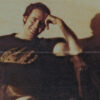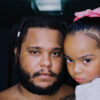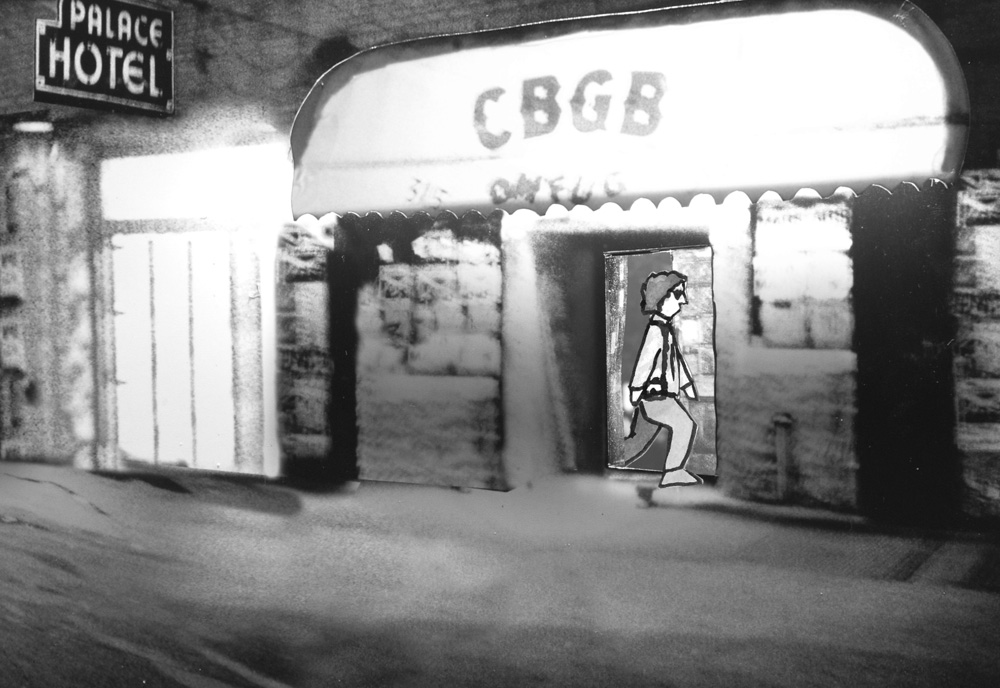“I’m going to make all these people look as interesting as a Ramones song sounds,” David Godlis recalls of his nightly sojourns to CBGBs at the height of the East Village club’s infamy during the 1970s in “Shots in the Dark with David Godlis,” playing no small part in its legendary status with the snapshots he took in which everyone who appeared in front of his lens looked like a rockstar.
When every picture is so striking, brothers Lewie and Noah Kloster thought better than to mess with perfection, but they nonetheless find a way to enhance Godlis’ work by turning all the individual photos he took into animated short in which they cut every frame by hand, having CBGBs patrons pop up with the same jagged edges that you could expect of them in person. Recognizing the soul inside the place as Godlis had, the Klosters throw you right into the mix as the photographer felt he had been just starting out, moonlighting at the club when shooting staid advertisements by day, with the images truly coming alive in a tactile, three-dimensional experience that runs from the basement where only the unexpected could be expected every night to the stage where revelers attending shows featuring Blondie and The Misfits were bound to spill onto the streets.
Narrated with great gusto by the street savvy Godlis, “Shots in the Dark” is just the latest bit of underground history that the Klosters have elevated to receive some well-deserved time in the sun, bringing out the scrappy ingenuity of their subjects in “Legal Smuggling with Christine Choy” and “Slinging Hash with Laurie Lindeen” with their creative, homemade brand of animation where their obvious attention to detail and elbow grease makes their affection for them infectious. With the film making its physical premiere tonight at the New York Film Festival at the Brooklyn Drive-In, playing in front of Joe DeNardo and Paul Felten’s feature “Slow Machine,” the Kloster Brothers generously took the time to talk about their latest short and reopening CBGBs, which closed in 2006, as best they could with this blast of pure fun.
How did this come about with David?
Lewie Kloster: I met him at a film premiere and he was on my radar because he does all the photography for the Lincoln Center – they tag him in all the posts because he works pro bono for them, so whenever the Lincoln Center posts one of his pictures for them, they tag him and put his name in the caption and all that, so I had been to his account once or twice and sprinkled in there heavily into his Instagram are CBGBs pictures. I’d been a fan of his without really realizing for years because I recognized so many of those pictures, and I couldn’t believe that the guy who was at CBGBs was at Lincoln Center.
Noah Kloster: And he’s not old, but a lot of those people from that time in New York in the late ’70s are dead, so when I was little, I thought because of that fact the Ramones played in the ‘50s, but they played pretty recently and here’s a guy that was there, so it was weird talking to him because I used to wear CBGBs on my T-shirt when I was little.
Lewis Kloster: I met him in 2016, so I’ve known him for a while, and we only really have interest in doing films with friends because it’s kind of a scary thing to make a film about someone you don’t really know. I remember my goal throughout making this thing was I want to make David Godlis cry when he sees it — a good cry, not a bad cry – and he’s so funny about how he talks about CBGBs because we talked to him for like 16 hours and most of the interview tape was just him being like, “It wasn’t mythic. It was just a shitty bar and that was it.” He is adamant that CBGBs wasn’t mythic, and we made sure to choose all the bits where he describes it in a more beautiful and surreal light.
Did David open up his archive to you or did you go from what work was already out there?
Lewie Kloster: He has a book out and it all started with me thumbing through the book and we really just did an adaptation, even though there’s not a single word that he wrote in it.
Noah Kloster: For some of the recording sessions, we had him flip through and tell us some of the stories about each photo and we chiseled out a story with his photos in mind. So we had his book for reference, but he also gave us his outtakes, the ones that didn’t make the book and we used a lot of those because we liked those pictures better than the ones of the celebrities because it makes it seem more like a regular old bar than just a bar with super mega famous rock’n’rollers hanging out. He gave us all the high-res pics and our producers bought us a really nice printer, and we went ahead and started printing them out and cutting them out.
Lewie Kloster: Yeah, but definitely a real wearing question on me while we were doing the interviews, was that he never really offered to send us his pictures and I knew that I was going to have to ask him. Every interview that went by, I would chicken out and it wasn’t until the third or fourth interview where I was like, “You know, David, we kind of need these pictures if we’re going to keep working on this.” [laughs] He played it off like he hadn’t even thought of it, but he later revealed to us that he was really nervous about it too, so the early interview sessions we had with him, it was like he was interviewing us to see if we were the right filmmakers to give it all to.
Was there an obvious focus on the club rather than the bands that played there from the start?
Lewie Kloster: David did give us a focus, but he didn’t directly give it to us. It was all based on his focus as a young photographer when he was at CBs in the ‘70s was just to document the place and the regulars and the loudmouths and the drunks. He despised rock ’n’ roll photography because that relies on the subject matter. Anyone can be a rock ’n’ roll photographer if you have a flash on your camera and access to Mick Jagger. He was so captivated with just documenting a scene instead, so he just photographed his friends and the bouncers and the doorman and the doorwomen…
Noah Kloster: Yeah, he was more focused on the night.
Lewie Kloster: When he was describing his book to us, he said he wanted his book to look like it was a brochure for the night that you’re about to have, just to give you the lay of the land, here are the characters you’re going to run into whether you like it or not, like the friends you make in the pit.
Noah Kloster: Or a cigarette you have outside. We really pulled at that and at first, we wanted to make a 14-minute movie and make it all very surreal and poetic because talking to David, it’s like there’s no end to a story. It’ll just keep going, so we wanted to have the movie feel like that and in a way we did. But we also had some producers that whipped us into shape and made it a really solid film and a nice beginning/middle/end feel and where it’s about the poetry of the night and who are the characters of the night and…
Lewie Kloster: What was the setting and how did it feel? That’s why he chose black and white photography too because he wanted to show how it felt. There are so many pictures that show exactly what CBGBs looks like, but his photos don’t show you exactly what CBGBs looks like, his pictures show you exactly what CBGBs felt like.
It’s remarkable because you really do feel like you’re there, in no small part because of how you orient a viewer and move around the space — I noticed this in your Laurie Lindeen short as well, which intricately replicates the experience of being inside Al’s Breakfast in Dinkytown. What type of geography is involved in creating something like this?
Lewie Kloster: It means the world that you said that. I love hole-in-the-wall places and that’s such a great setting because it’s such a bounded universe that you can have a tidy, sweet, cute, wholesome story to take place.
Noah Kloster: Yeah, there’s no way we could make a movie about the Olive Garden. [laughs] I think we’re romantics and we like things that are old and…
Lewie Kloster: Small and cramped.
Noah Kloster: And yeah, a lot of geography was involved with this. We never did it, but we wanted to draw out CBGBs and pin each photo to where [David] was standing [to take a picture] and what it’s of, and make almost like a 3D rendering, but we don’t have the technological knowhow to do that. There is that shot of the car from afar and then there’s that rotation to the kids on the car outside of CBGBs and they were sitting outside CBGBs, but the camera was pointed in the opposite direction. In real life, it’s now a John Varvatos, which sucks, but we went in and looked around and got an idea for how long the establishment is and where the basement was, or where the stairs down were. I’m a spatial guy. I love navigating cities and I’m usually pretty good at directions and stuff, so I’m really good at plotting out in my head the perfect memory palace of CBGBs from David’s photos. That’s the same thing we did with Al’s Breakfast, and it’s funny because Al’s and CBs are very similar in dimension. They’re both really long…
Lewie Kloster: And very similar in feeling too. I would honestly say Al’s Breakfast is the CBGB’s of Minneapolis, even though it has nothing to do with music. [laughs]
Noah Kloster: But Al’s is a little smaller. CB’s has probably got maybe seven feet on each side, on the right hand side.
It’s actually good to hear you resisted the temptation of using a computer because the tactile sensation from the animation is really wonderful – how did that style come to you?
Noah Kloster: I think it came from not knowing what to do. Like in the movie “Adaptation,” the character Nic Cage [plays] says he just wants to make a movie about flowers, so we just wanted to make a movie of these pictures. We didn’t really want to do any other legwork because we wanted his pictures to be the standalone visual, so we did a lot of experimentation with how we could make his photos move, whether they’re digitally moving or physically moving in space. We landed on the pop-up book style look of cutting out his photos and putting them over the backgrounds in which they existed, but separating them out in Photoshop and them printing them separately and adjusting the sizes accordingly for how far and how close the subject would be from the background. Eventually, we figured out how to add smoke. For a while, we thought about smoking cigarettes in our apartment and blowing smoke at the photos as we were shooting, but we realized incense works way better, so we were burning incense. And Lewie figured out this awesome way of making things glow by making a mask of cardboard behind the printed out photo and having the light go through the holes of the mask [with] the cardboard stopping the light — like the jukebox, for example, glows as it turns on.
Lewie Kloster: A lot of why we landed on actually doing it real instead of digitally also was because flipping through his book, I brought a razor blade and I started cutting it up and figuring out how we could do a type of collage-style movie. But we also figured out that David didn’t just take one picture of one instance. Like any photographer, he took like three or four pictures in a row, so every shot that he has, there’s two or three outtakes for it and when he gave us those outtakes, I sized them up, so they could match cut together and we animated them, especially with the sequence where he says he figured out what to do with the photography.
Noah Kloster: Yeah, the shutter goes and when the shutter clicks, the photo is switched and it gives it a living quality.
One of my favorite moments in the film is where you see how David learns to develop of the photos and the single picture gradually comes into focus from a blur.
Lewie Kloster: Yeah, that was Noah, who brought some of those photos into Photoshop and figured out how to layer them up and then did ink paintings based on the layers.
Noah Kloster: Yeah, I did three ink paintings of each shade of gray, darkest to lightest, so I had 12 drawings and probably 12 paintings and really cycled through them and then made them look like they’re shimmering and they slowly came together.
What was it like to show it to David?
Lewie Kloster: We didn’t get to hang out while he watched it, which is a good thing…
Noah Kloster: I always hate that, looking at the person while watching their reactions and [because of] the COVID stuff, we couldn’t really hang out with him much in person, so we sent him the link.
Lewie Kloster: He’s the kind of guy who watches and rewatches films all the time. He loves Bob Dylan, so when “Rolling Thunder Revue” came out, he saw the premiere and then went home and watched it on Netflix right away. He’s hilarious like that and he is the sweetest. He’s gone on since to describe [this film] as like a really good 45 record, like it’s just the right length, it’s replayable and when you put it on the turntable, you just want to reloop it a few times. That was the sweetest compliment anyone could give it.
“Shots in the Dark with David Godlis” will screen physically at the New York Film Festival, along with “Slow Machine,” at the Brooklyn Drive-In on October 8th at 8 pm.




